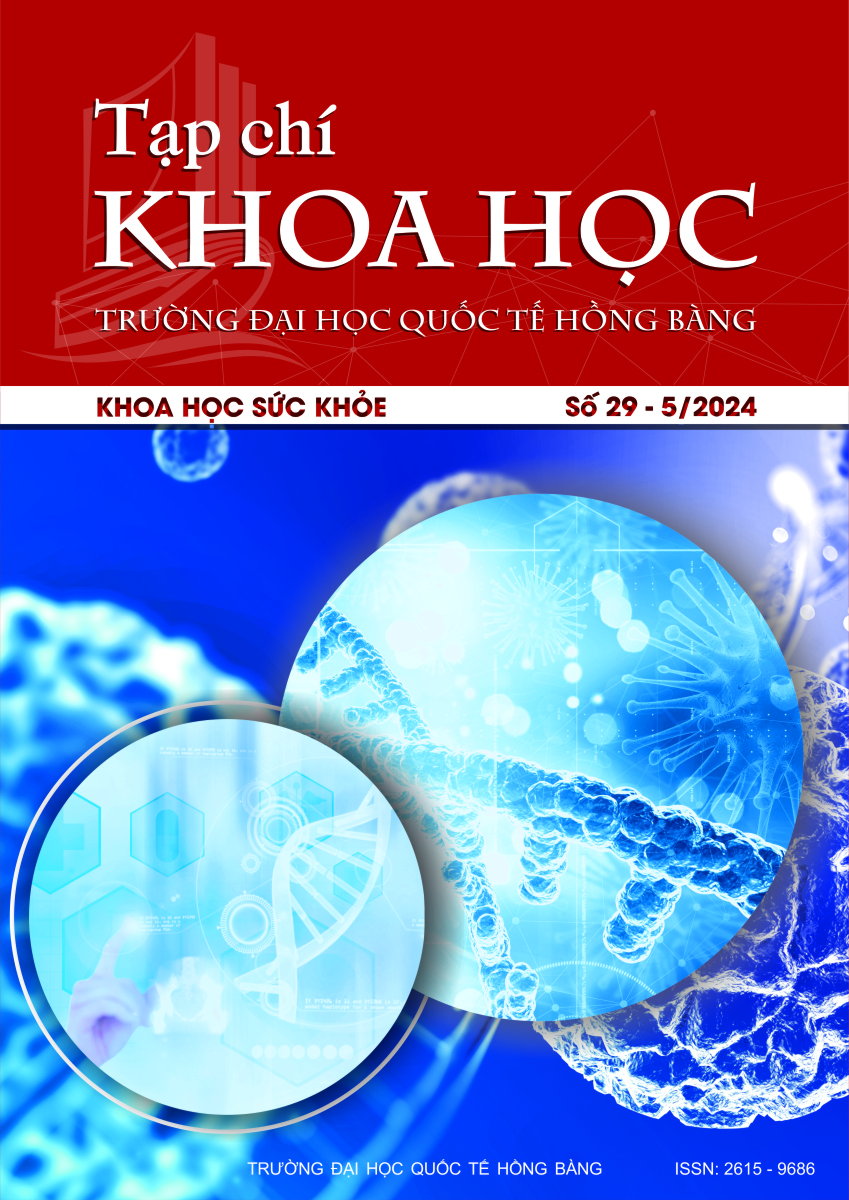Nghiên cứu tổng hợp nano bạc bằng hóa học xanh sử dụng dịch chiết vỏ quả măng cụt (Garcinia mangostana L.) ứng dụng kháng khuẩn
Các tác giả
DOI: https://doi.org/10.59294/HIUJS.29.2024.621Từ khóa:
Nano bạc, vỏ măng cụt, Garcinia mangostana L., dịch chiết, kháng khuẩnTóm tắt
Mục tiêu: Tổng hợp hạt nano bạc (AgNPs) bằng phương pháp hóa học xanh sử dụng dịch chiết vỏ quả măng cụt (Garcinia mangostana L.), đánh giá tính chất hóa lý và khả năng kháng khuẩn của dung dịch AgNPs. Đối tượng và phương pháp nghiên cứu: Trong nghiên cứu này, AgNPs được tổng hợp bằng phương pháp khử sử dụng các chất khử tự nhiên trong dịch chiết từ nguồn phế phẩm vỏ quả măng cụt. Khả năng phản ứng tổng hợp AgNPs của dịch chiết được đánh giá bằng phổ UV-Vis. Kích thước và hình thái của AgNPs được đánh giá bằng phương pháp DLS. Cấu trúc hóa học của AgNPs được chứng minh bằng phổ EDX. Khả năng kháng khuẩn được đánh giá bằng phương pháp đo vòng kháng khuẩn. Kết quả nghiên cứu: Tổng hợp thành công dung dịch AgNPs từ dịch chiết vỏ quả măng cụt và muối AgNO3 với nồng độ lần lượt là 2.5% và 0.2 M, thời gian phản ứng 30 phút, nhiệt độ phản ứng 95°C. Kết quả DLS cho thấy hạt AgNPs có kích thước động học khoảng 49.0 nm và tương đối đồng đều với độ đa phân tán PI = 0.324. Kết quả phổ EDX đã chứng minh cấu trúc hóa học của AgNPs. Dung dịch AgNPs có khả năng kháng khuẩn trên dòng Pseudomonas aeruginosa. Kết luận: Nghiên cứu đã tổng hợp, đánh giá tính chất hóa lý, và khả năng kháng khuẩn của dung dịch AgNPs sử dụng dịch chiết tận dụng từ nguồn phế phẩm vỏ quả măng cụt nhằm ứng dụng trong các sản phẩm bảo vệ sức khỏe.
Abstract
Objective: Synthesis of silver nanoparticles (AgNPs) by green chemistry using mangosteen peel extract (Garcinia mangostana L.), then characterize physicochemical properties and evaluate antibiotics activity of the AgNPs. Materials and method: In this study, AgNPs were synthesized by reductive reaction using botanicals in the extract of waste-resourced mangosteen peels. The reaction efficiency was evaluated by UV-Vis. The particle size of the AgNPs was measured by DLS. The chemical structure of AgNPs was demonstrated by EDX. The antibacterial activity was evaluated by zone of inhibition test. Results: The AgNPs were successfully synthesized from mangosteen peel extract and AgNO3 with the concentration of 2.5% and 0.2 M, respectively, stirring for 30 minutes, under temperature of 95 °C The DLS results show that AgNPs have dynamic particle size of 49.0 nm with PI = 0.324. The EDX results demonstrate the chemical structure of AgNPs. The AgNPs have antibacterial activity when testing on Pseudomonas aeruginosa. Conclusion: The AgNPs were synthesized via green chemistry using waste-resourced mangosteen peel extract. The physicochemical properties and antibacterial activity of the AgNPs were evaluated for antibiotic applications.
Tài liệu tham khảo
[1] Gorbach, S.L., J.G. Bartlett, and N.R. Blacklow. Infectious diseases. Lippincott Williams & Wilkins, 2004.
[2] Mandell, G.L., J.E. Bennett, R. Dolin, and D.A. Schwartz. "Principles and practice of infectious disease,"
Archives of Pathology Laboratory Medicine, vol. 121, no. 8, pp. 908, 1997.
[3] Mena, K.D. and C.P. Gerba. "Risk assessment of Pseudomonas aeruginosa in water," Reviews of environmental contamination toxicology, vol. 201, pp. 71-115, 2009.
DOI: https://doi.org/10.1007/978-1-4419-0032-6_3[4] Radzig, M., et al. "Antibacterial effects of silver nanoparticles on gram-negative bacteria: influence on the growth and biofilms formation, mechanisms of action," Colloids Surfaces B: Biointerfaces, vol. 102, pp. 300-306, 2013.
DOI: https://doi.org/10.1016/j.colsurfb.2012.07.039[5] Rizzello, L. and P.P. Pompa. "Nanosilver-based antibacterial drugs and devices: mechanisms, methodological drawbacks, and guidelines," Chemical Society Reviews, vol. 43, no. 5, pp. 1501-1518, 2014.
DOI: https://doi.org/10.1039/C3CS60218D[6] Franci, G., et al. "Silver nanoparticles as potential antibacterial agents," Molecules, vol. 20, no. 5, pp. 8856-8874, 2015.
DOI: https://doi.org/10.3390/molecules20058856[7] Mulvaney, P. "Surface plasmon spectroscopy of nanosized metal particles," Langmuir, vol. 12, no. 3, pp. 788-800, 1996.
DOI: https://doi.org/10.1021/la9502711[8] Khan, M., et al. "Green synthesis of silver nanoparticles mediated by Pulicaria glutinosa extract,"
International journal of nanomedicine, pp. 1507-1516, 2013.
[9] Sultana, N., et al. "Bio-nanoparticle assembly: A potent on-site biolarvicidal agent against mosquito vectors," RSC advances, vol. 10, no. 16, pp. 9356-9368, 2020.
DOI: https://doi.org/10.1039/C9RA09972G[10] Rani, P., et al. "Highly stable AgNPs prepared via a novel green approach for catalytic and photocatalytic removal of biological and non-biological pollutants," Environment International, vol. 143, pp. 105924, 2020.
DOI: https://doi.org/10.1016/j.envint.2020.105924[11] Kharat, S.N. and V.D. Mendhulkar. "Synthesis, characterization and studies on antioxidant activity of silver nanoparticles using Elephantopus scaber leaf extract," Materials Science Engineering: C, vol. 62, pp. 719-724, 2016.
DOI: https://doi.org/10.1016/j.msec.2016.02.024[12] Panda, M.K., N.K. Dhal, M. Kumar, P.M. Mishra, and R.K. Behera. "Green synthesis of silver nanoparticles and its potential effect on phytopathogens," Materials Today: Proceedings, vol. 35, pp. 233-238, 2021.
DOI: https://doi.org/10.1016/j.matpr.2020.05.188[13] Owaid, M.N., et al. "Mycosynthesis of silver nanoparticles by Pleurotus cornucopiae var. citrinopileatus and its inhibitory effects against Candida sp," Materials Letters, vol. 153, pp. 186-190, 2015.
DOI: https://doi.org/10.1016/j.matlet.2015.04.023[14] Sun, Y. and Y. Xia. "Gold and silver nanoparticles: a class of chromophores with colors tunable in the range from 400 to 750 nm," Analyst, vol. 128, no. 6, pp. 686-691, 2003.
DOI: https://doi.org/10.1039/b212437h[15] Ahmed, S., M. Ahmad, B.L. Swami, and S. Ikram. "Green synthesis of silver nanoparticles using Azadirachta indica aqueous leaf extract," Journal of radiation research applied sciences, vol. 9, no. 1, pp. 1-7, 2016.
DOI: https://doi.org/10.1016/j.jrras.2015.06.006Tải xuống
Tải xuống: 372











